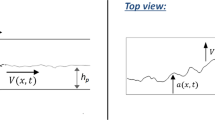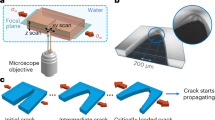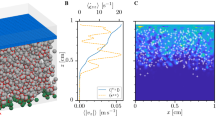Abstract
When a brittle material is loaded to the limit of its strength, it fails by the nucleation and propagation of a crack1. The conditions for crack propagation are created by stress concentration in the region of the crack tip and depend on macroscopic parameters such as the geometry and dimensions of the specimen2. The way the crack propagates, however, is entirely determined by atomic-scale phenomena, because brittle crack tips are atomically sharp and propagate by breaking the variously oriented interatomic bonds, one at a time, at each point of the moving crack front1,3. The physical interplay of multiple length scales makes brittle fracture a complex ‘multi-scale’ phenomenon. Several intermediate scales may arise in more complex situations, for example in the presence of microdefects or grain boundaries. The occurrence of various instabilities in crack propagation at very high speeds is well known1, and significant advances have been made recently in understanding their origin4,5. Here we investigate low-speed propagation instabilities in silicon using quantum-mechanical hybrid, multi-scale modelling and single-crystal fracture experiments. Our simulations predict a crack-tip reconstruction that makes low-speed crack propagation unstable on the (111) cleavage plane, which is conventionally thought of as the most stable cleavage plane. We perform experiments in which this instability is observed at a range of low speeds, using an experimental technique designed for the investigation of fracture under low tensile loads. Further simulations explain why, conversely, at moderately high speeds crack propagation on the (110) cleavage plane becomes unstable and deflects onto (111) planes, as previously observed experimentally6,7.
This is a preview of subscription content, access via your institution
Access options
Subscribe to this journal
Receive 51 print issues and online access
$199.00 per year
only $3.90 per issue
Buy this article
- Purchase on Springer Link
- Instant access to full article PDF
Prices may be subject to local taxes which are calculated during checkout
 crack system.
crack system.


 crack system.
crack system.

Similar content being viewed by others
References
Lawn, B. Fracture of Brittle Solids 2nd edn (Cambridge Univ. Press, 1993)
Broberg, K. B. Cracks and Fracture Ch. 3, 4 (Academic, 1999)
Lin, I. H. & Thomson, R. Cleavage, dislocation emission, and shielding for cracks under general loading. Acta Metall. 34, 187–206 (1986)
Marder, M. Effects of atoms on brittle fracture. Int. J. Fract. 130, 517–555 (2004)
Buehler, M. J. & Gao, H. J. Dynamical fracture instabilities due to local hyperelasticity at crack tips. Nature 439, 307–310 (2006)
Sherman, D. & Be’ery, I. From crack deflection to lattice vibrations—macro to atomistic examination of dynamic cleavage fracture. J. Mech. Phys. Solids 52, 1743–1761 (2004)
Cramer, T., Wanner, A. & Gumbsch, P. Energy dissipation and path instabilities in dynamic fracture of silicon single crystals. Phys. Rev. Lett. 85, 788–791 (2000)
Griffith, A. A. The phenomena of rupture and flow in solids. Phil. Trans. R. Soc. Lond. A 221, 163–198 (1921)
Freund, L. B. Dynamic Fracture Mechanics (Cambridge Univ. Press, 1990)
Field, J. E. Brittle fracture: its study and application. Contemp. Phys. 12, 1–31 (1971)
Hauch, J. A., Holland, D., Marder, M. P. & Swinney, H. L. Dynamic fracture in single crystal silicon. Phys. Rev. Lett. 82, 3823–3826 (1999)
Be’ery, I., Lev, U. & Sherman, D. On the lower limiting velocity of a dynamic crack in brittle solids. J. Appl. Phys. 93, 2429–2434 (2003)
Gally, B. J. & Argon, A. S. Brittle-to-ductile transitions in the fracture of silicon single crystals by dynamic crack arrest. Phil. Mag. A 81, 699–740 (2001)
Thomson, R., Hsieh, C. & Rana, V. Lattice trapping of fracture cracks. J. Appl. Phys. 42, 3154–3160 (1971)
Sinclair, J. E. The influence of the interatomic force law and of kinks on the propagation of brittle cracks. Phil. Mag. 31, 647–671 (1975)
Cook, R. F. & Linegar, E. G. Kinetics of indentation cracking in glass. J. Am. Ceram. Soc. 76, 1096–1105 (1993)
Riedle, J., Gumbsch, P. & Fischmeister, H. F. Cleavage anisotropy in tungsten single crystals. Phys. Rev. Lett. 76, 3594–3597 (1996)
Perez, R. & Gumbsch, P. Directional anisotropy in the cleavage fracture of silicon. Phys. Rev. Lett. 84, 5347–5350 (2000)
van Eck, H., van der Laan, D., Dhallé, M., ten Haken, B. & ten Kate, H. Critical current versus strain research at the University of Twente. Supercond. Sci. Technol. 16, 1026–1030 (2003)
Csányi, G., Albaret, T., Payne, M. & De Vita, A. “Learn on the fly”: A hybrid classical and quantum-mechanical molecular dynamics simulation. Phys. Rev. Lett. 93, 175503 (2004)
Pandey, K. C. New π-bonded chain model for Si(111)–(2×1) surface. Phys. Rev. Lett. 47, 1913–1917 (1981)
Hoshi, T., Igushi, T. & Fujiwara, T. Nanoscale structures formed in silicon cleavage studied with large-scale electronic structure calculations: Surface reconstruction, steps, and bending. Phys. Rev. B 72, 075323 (2005)
Sherman, D., Markovitz, M. & Barkai, O. Dynamic instabilities in 111 silicon. J. Mech. Phys. Solids 56, 376–387 (2008)
Lange, F. F. The interaction of a crack front with a second-phase dispersion. Phil. Mag. 22, 983–992 (1970)
Sherman, D. Macroscopic and microscopic examination of the relationship between crack velocity and path and Rayleigh surface wave speed in single crystal silicon. J. Mech. Phys. Solids 53, 2742–2757 (2005)
Stillinger, F. H. & Weber, T. A. Computer simulation of local order in condensed phases of silicon. Phys. Rev. B 31, 5262–5271 (1985)
Segall, M. D. et al. First-principles simulation: ideas, illustrations and the CASTEP code. J. Phys. Condens. Mater. 14, 2717–2743 (2002)
Sanchez-Portal, D., Ordejón, P., Artacho, E. & Soler, J. M. Density-functional method for very large systems with LCAO basis sets. Int. J. Quantum Chem. 65, 453–461 (1997)
Kwon, I., Biswas, R., Wang, C., Ho, K. & Soukoulis, C. Transferable tight-binding models for silicon. Phys. Rev. B 49, 7242–7250 (1994)
Sharon, E., Cohen, G. & Fineberg, J. Propagating solitary waves in a rapidly moving crack front. Nature 410, 68–71 (2001)
Acknowledgements
P.G. acknowledges support from the Deutsche Forschungsgemeinschaft (Gu 367/30). N.B. acknowledges support from NRL and ONR. D.S. acknowledges support from the ISF (grant no. 1110/04). J.R.K., G.C. and M.C.P. acknowledge support from the EPSRC portfolio grant GR/S61263/01. T.A. acknowledges support from ANR–France (grant ANR–05–CIGC:LN3M) and IDRIS (Orsay, France, project 051841). A.D.V. acknowledges support from the EPSRC grant EP/5C23938/1. G.C. acknowledges support from the EPSRC grant EP/C52392X/1. The authors thank A. Sutton for a critical reading of the manuscript. Computer time was in part provided by the US Department of Defense HPCMP and the HPCS at the University of Cambridge.
Author information
Authors and Affiliations
Corresponding author
Supplementary information
Supplementary Information
This file contains Supplementary Notes with Supplementary Figures S1-S3 and S6- S13 with Legends (PDF 5370 kb)
Rights and permissions
About this article
Cite this article
Kermode, J., Albaret, T., Sherman, D. et al. Low-speed fracture instabilities in a brittle crystal. Nature 455, 1224–1227 (2008). https://doi.org/10.1038/nature07297
Received:
Accepted:
Issue Date:
DOI: https://doi.org/10.1038/nature07297
This article is cited by
-
Atomistic fracture in bcc iron revealed by active learning of Gaussian approximation potential
npj Computational Materials (2023)
-
Reinforcing materials modelling by encoding the structures of defects in crystalline solids into distortion scores
Nature Communications (2020)
-
High-throughput screening of the static friction and ideal cleavage strength of solid interfaces
Scientific Reports (2019)
-
Topological defects govern crack front motion and facet formation on broken surfaces
Nature Materials (2018)
Comments
By submitting a comment you agree to abide by our Terms and Community Guidelines. If you find something abusive or that does not comply with our terms or guidelines please flag it as inappropriate.



